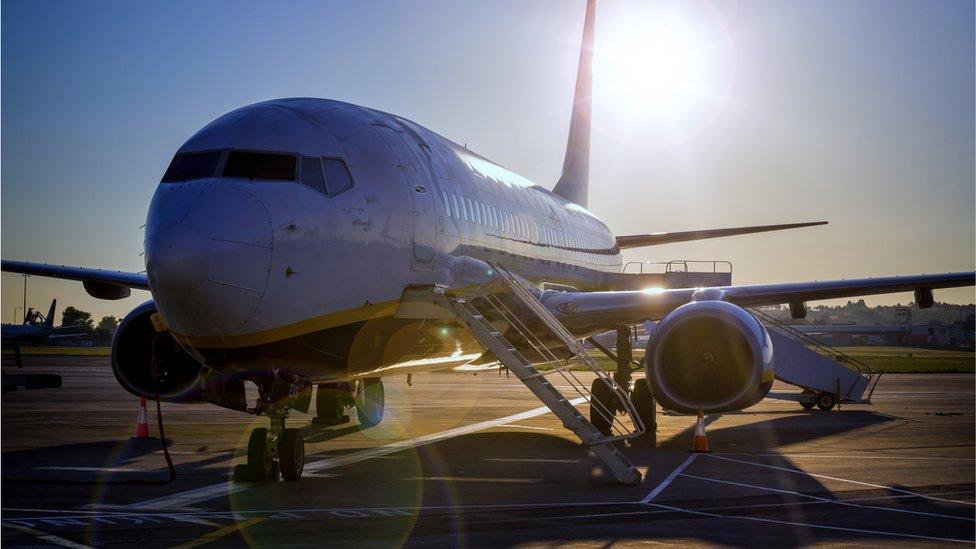Who’s left when the furlough music stops?
- Published

There are roughly as many people on furlough as there are job vacancies, but don't expect the two to match as furlough winds up.
The typical person on furlough remains older, male and in vulnerable sectors led by air travel and the arts.
Unions want to see furlough retained - not just into autumn, but as a permanent option when economies hit crisis point. But it's a very expensive option.
We're nearing the end of the road for furlough, due to be phased out at the end of this month.
Or are we? Could this be the end of the beginning?
Having done sterling service in keeping the unemployment queue from getting very, very long, it is being wound down at a time when said queue is short, and has been throughout the pandemic. Indeed, there have never been so many job vacancies.
So if the jobs market worked perfectly, the million or so people still on furlough in July should fit comfortably into the million or so vacancies.
They won't, of course. Not everyone who faces the end of furlough with uncertainty about whether they'll have a job is able or willing to pick up the jobs that are available.
No-one can train that quickly to become a consultant physician. Few could do so, even given the 10 years necessary.
The vacancies include chefs, lorry drivers, care home assistants and berry pickers, and not everyone can easily fit into those jobs, or turn up where they're required.
Corporate pie
This is one effect of Brexit. Without access to the wider European labour pool to fill those gaps, Britain has to turn in on itself.
The good news is for those who work in occupations with those vacancies. This is a good time to ask for a pay rise. And for care assistants, agricultural labourers and truck drivers, many have a strong case for higher pay.

Some sectors such as agriculture have found it hard to attract workers
But until they can be found, the bad news is that feeds through to shortages in deliveries, fields that go unharvested, and gaps where there's a need for social care services.
Long term, it reorients the economy to some of those lower paid occupations getting a bigger share of the corporate pie. In some cases, it leads to more automation.
In some industries, new patterns of trade will render them uncompetitive and they may gradually disappear. That's what sheep farmers fear from the trade deal done with Australia and the next one likely with New Zealand.
Redundancies
But in the shorter term, the latest figures for furlough point to the areas most at risk from its removal.
The most recent figures give us a picture to the end of July, showing that the person remaining on furlough is typically male and older, furloughed by a small firm, and while London has the highest figures, the highest in Scotland are in and around Glasgow.

More than half of workers in air travel were still furloughed in July
Air travel is the most dependent with 51% of eligible workers on furlough in July. That's nearly 30,000 across the UK. It includes nearly half of employers in the sector.
Travel agencies and tour operators are up there as well, with 46% and 27,000 people.
A survey by the Scottish Passenger Agents Association found its members last month had 72% of staff on furlough, and they are looking gloomily at the likelihood of redundancies.
A quarter of those in conventions and trade shows were furloughed, and in "creative, arts and entertainment", it was 28%.
Older recruits
In Scotland, the number on furlough has fallen from the second peak, in January at nearly 400,000, to 116,000 in July. Of those, nearly 24,000 were in accommodation and food services. Despite the strong staycation figures, they didn't extend so much to city hotels. More than a third were in either Edinburgh or Glasgow.
In arts and entertainment, Scotland had 8,300 people furloughed. Again, many were in the bigger cities.
Some 36% of the total Scottish number was aged over 50. That underlines the trend over previous months of younger people leaving furlough and going back into the workforce, often in hospitality and mostly women.
Until May, there were more women than men furloughed, and since then, men have been the majority.
Across the UK, the proportion of eligible 18 to 24 year olds fell from 24% furloughed last January to 5% in July, while the proportion of over-65s went down from 19% to 8%.
For older people, furlough may be their means of putting off retirement, forced or voluntary, and perhaps because it pays better than their pensions do.
It is no secret that older people find it more difficult to get into jobs, or even be onsidered for them, and they are more likely to lack the skills being sought.
Cash burn
The total numbers for furlough are astonishing. For a policy that hadn't been invented 18 months ago, it covered 11.6 million people, and helped 1.3 million employers retain their workers.
At the peak, in May last year, there were 8.86m people furloughed across the UK, and January's peak was just over 5m.
And the cost? By July, a staggering £68.5bn. That's £6bn more than all the tax paid by Scots last financial year.
And that cost is one reason the Treasury is not that keen on an idea being pushed this week at the Trades Union Congress - that furlough should remain part of the toolkit for government of handling crises of all sorts.
Professor Melanie Simms, an expert in employment at Glasgow University, argues that it has the advantage of giving companies time to plan how they get through a crisis and in what shape they come out the other side. Time is usually what such companies lack most as they burn through cash.

Furlough was used in Iceland to help the airline industry in 2010 when a volcanic eruption disrupted travel
She points out that the furlough idea was used by the airline industry to get it through the crises after the September 11 attacks in the US, and after Iceland's volcanic ash closed the skies. It knows what to do, but having sustained losses of more than $100bn last year, it now lacks the deep pockets to run its own wage support system.
Furlough was used also by European governments to handle systemic crises. Germany used a form of furlough to get it through the financial crash in 2008, and was early into adopting it last year.
Prof Simms argues that one reason it worked in Germany and again worked beyond expectations even of those who devised it last year for the UK is that it was designed by employers and unions together. There may be a longer term lesson to be learned there.